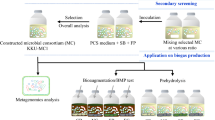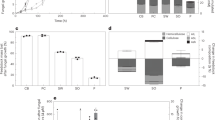Abstract
Lignocelluloses are a major source of carbon into ecosystems and represent the principal constituent of agricultural, forestry and municipal wastes. The large proportion of cellulose and hemicellulose in these wastes leads to a high C:N ratio which often results in N limitation during decomposition. This could be overcome if the decomposer organisms combined both the cellulolytic (cellulase) and N2-fixing (nitrogenase) functions. With the exception of bacteria isolated from the specialized environment of marine shipworms1,2, no organism possessing both cellulase and nitrogenase has yet been isolated from nature or genetically engineered. We now report the cooperative degradation of cellulose in which the fungus Trichoderma harzianum provides the cellulase function and an obligately anaerobic bacterium, Clostridium butyricum, provides the nitrogenase function. These co-cultures utilized cellulose as the sole carbon source for N2 fixation, resulting in a substantial increase in the rate of substrate decomposition compared with the fungus alone. The co-cultures developed in apparently aerobic environments, demonstrating that aerobes and anaerobes can co-exist, the aerobe presumably providing respiratory protection to the anaerobe.
This is a preview of subscription content, access via your institution
Access options
Subscribe to this journal
Receive 51 print issues and online access
$199.00 per year
only $3.90 per issue
Buy this article
- Purchase on Springer Link
- Instant access to full article PDF
Prices may be subject to local taxes which are calculated during checkout
Similar content being viewed by others
References
Carpenter, E. J. & Culliney, J. I. Science 187, 551–552 (1975).
Waterbury, J. B., Calloway, C. B. & Turner, R. D. Science 221, 1401–1403 (1983).
Yoneyamu, T., Lee, K. K. & Yoshida, T. Soil Sci. Pl. Nutr. 23, 287–295 (1977).
Rice, W. A. & Paul, E. A. Can. J. Microbiol. 18, 715–723 (1972).
Lynch, J. M. & Harper, S. H. T. J gen. Microbiol. 129, 251–253 (1983).
Harper, S. H. T. & Lynch, J. M. J. appl. Bact. (in the press).
Haines, E. B. & Hanson, R. B. J. exp. mar. Biol. Ecol. 40, 27–40 (1979).
Aho, P. E., Seidler, R. S., Evans, H. J. & Nelson, A. D. in Proc. Int. Symp. Nitrogen Fixation (eds Newton, W. E. & Nynman, C. J.) 629–690 (Washington State University Press, Pullman, 1976).
Silvester, B., Sollins, T., Verhoeven, T. & Cline, S. P. Can. J. For Res. 12, 646–652 (1982).
Barrow, N. J. & Jenkinson, D. S. Pl. Soil 16, 258–262 (1962).
Buresh, R. J., Casselman, M. E. & Patrick, W. H. Adv. Agron. 33, 149–192 (1980).
Magdoff, F. R. & Bouldin, D. R. Pl. Soil 33, 49–61 (1970).
Jensen, H. L. Proc. Linn. Soc. N.S.W. 66, 239–249 (1941).
Vartiovaara, U. J. Sci. agric. Soc. Finl. 10, 241–264 (1938).
Postgate, J. R. – Hill, S. in Microbial Ecology; A Conceptual Approach (eds Lynch, J. M. & Poole, N. J.) 191–213 (Blackwell, Oxford, 1979).
Lynch, J. M., Harper, S. H. T., Chapman, S. J. & Veal, D. A. in Microbial Methods for Environmental Biotechnology (eds Grainger, J. M. & Lynch, J. M. (Academic, New York, in the press).
Dalton, H. & Postgate, J. R. J. gen. Microbiol. 56, 307–319 (1969).
Postgate, J. R. in Methods in Microbiology Vol. 6B in (eds Norris, J. R. & Ribbons, D. W.) 343–356 (Academic, London, 1972).
Lynch, J. M. J. appl. Bact. 42, 81–87 (1977).
Sedmak, J. J. & Grossberg, S. E. Analyt. Biochem. 79, 544–552 (1977).
Author information
Authors and Affiliations
Rights and permissions
About this article
Cite this article
Veal, D., Lynch, J. Associative cellulolysis and dinitrogen fixation by co-cultures of Trichoderma harzianum and Clostridium butyricum. Nature 310, 695–697 (1984). https://doi.org/10.1038/310695a0
Received:
Accepted:
Issue Date:
DOI: https://doi.org/10.1038/310695a0
Comments
By submitting a comment you agree to abide by our Terms and Community Guidelines. If you find something abusive or that does not comply with our terms or guidelines please flag it as inappropriate.



